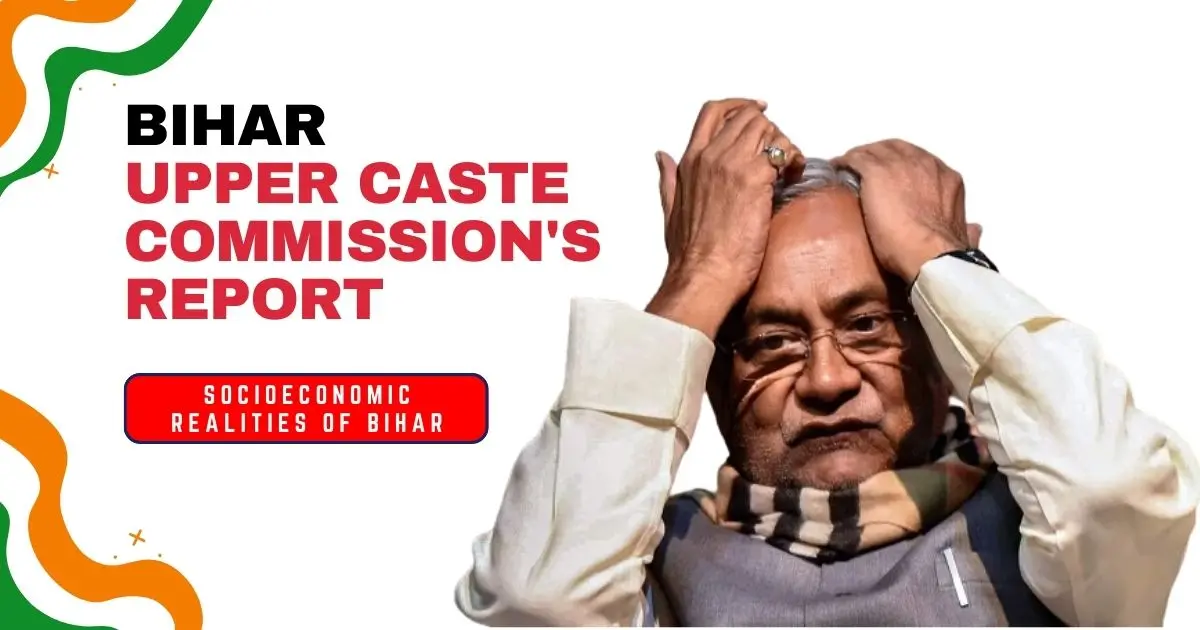In a surprising turn of events, the recently released report from the Bihar Upper Caste Commission has sent shockwaves through the political corridors and societal narratives of the state. Contrary to conventional wisdom, the report has exposed the hidden struggles faced by the upper caste population, raising questions about the longstanding assumptions that have shrouded their socioeconomic status.
As the dust settles from these revelations, it becomes clear that the veneer of privilege often attributed to the upper castes might not be as solid as previously thought.
Page Index
Report
Breakdown of the staggering statistics revealed by the Bihar Upper Caste Commission’s report:
Economic Realities
- A striking 46% of the upper caste population in Bihar continues to rely on agriculture, even as land ownership dynamics evolve.
- Remarkably, 55% of the upper caste individuals find themselves without a single acre of land to call their own, challenging the perception of universal land ownership.
- The report underscores that 33.4% of the upper caste population lacks any cultivable land, revealing a significant disparity in access to agricultural resources.
Housing Inequalities
- Startlingly, 20% of the upper caste population lacks a pucca (permanent) house, raising questions about the widespread assumption of stable living conditions.
- The data further indicates that 19.9% of the upper caste community resides in Kutcha houses and huts, painting a vivid picture of the housing challenges faced.
Socioeconomic Struggles
- Around 36% of the upper caste population lives below the poverty line, making them eligible for the Below Poverty Line (BPL) card.
- In a revealing comparison, 48.7% of the rural population holds Above Poverty Line (APL) cards, shedding light on disparities within rural society.
Education Disparities
- A staggering 90% of rural youth within the upper caste spectrum are without a college degree, a significant statistic that challenges assumptions about education access.
- Nearly half, 49%, of upper-caste children in rural areas are forced to drop out of school due to financial constraints, highlighting a pressing issue of access and affordability.
Education Challenges
- The report highlights that 16% of children miss school due to domestic work responsibilities, offering insight into the struggles faced by young students.
- Alarmingly, 9.6% of parents within the upper caste community believe that formal education is not essential, adding a nuanced layer to the education discourse.
Migration Patterns
- Approximately 43.5% of the upper caste rural population is forced into migration, emphasizing the economic challenges that drive migration trends in Bihar.
- An overwhelming 65.6% of the upper caste population leaves their homes in pursuit of job opportunities within Bihar, painting a picture of the state’s employment landscape.
These statistics paint a vivid portrait of the complex socioeconomic realities faced by the upper-caste population in Bihar. The report’s findings underscore the need for a comprehensive approach to policy-making that acknowledges and addresses the multifaceted challenges within the state’s societal fabric.
From a political perspective, the timing and implications of the report cannot be overlooked. As the findings challenge prevailing narratives and expose gaps in governance, they force political leaders to reevaluate their strategies and promises.
The report provides an intricate snapshot of the economic realities experienced by the upper caste community in Bihar. Perhaps the most astonishing revelation is that a substantial 46% of the upper caste population relies on agriculture as their primary means of sustenance.
This revelation dismantles the preconceived notion that the upper castes solely enjoy economic affluence. Furthermore, the startling statistic that over half of the upper caste individuals do not possess a single acre of land casts doubt on the conventional narrative of their inherent prosperity.
Housing, another crucial facet of socioeconomic well-being, takes center stage in the report’s findings. Astonishingly, nearly 20% of the upper caste population lacks access to a concrete, permanent dwelling. Equally alarming is the revelation that approximately one-fifth of the population resides in kutcha houses and huts, casting a shadow over the conventional belief that the upper castes uniformly enjoy superior living conditions.
Education, often viewed as the cornerstone of social progress, receives its share of scrutiny in the report. Contrary to popular perceptions, the report unveils a stark reality: a staggering 90% of rural youth lack a college degree.
This fact serves as a poignant reminder that educational disparities are not confined to specific castes alone. The dropout rate among upper caste children in rural areas due to poverty stands at nearly 50%, shining a harsh light on the inadequacies of Bihar’s educational infrastructure.
Migration, a phenomenon that has affected countless lives across the nation, plays a significant role in the lives of the upper caste population in Bihar. The report divulges that a substantial 43.5% of the rural populace is compelled to migrate due to limited opportunities, contradicting political promises of stemming the tide of migration. This revelation underscores the critical need for addressing unemployment and providing meaningful economic prospects.
The report’s release exposes not just the challenges faced by one specific caste but also the intricate web of interconnected issues that permeate society. It serves as a wake-up call for leaders to devise comprehensive and inclusive policies that uplift all segments of the population.
The release of the Bihar Upper Caste Commission’s report opens a new chapter in the state’s political landscape. It offers an opportunity to transcend divisive politics and redefine the trajectory of Bihar’s development.
Instead of perpetuating caste-based divisions, the report beckons leaders to embrace a united approach, acknowledging shared challenges, and collaborating to foster a more equitable and prosperous Bihar for all its citizens.
As Bihar stands at a crossroads, it remains to be seen whether the state’s leadership will seize this pivotal moment to create a future that truly reflects the aspirations and needs of its diverse population.
The Bihar Upper Caste Commission’s report is more than just a collection of statistics; it’s a call to action, a plea for transformation, and an affirmation that progress can only be achieved when the collective well-being of all citizens is prioritized above preconceived notions and political expediency.


